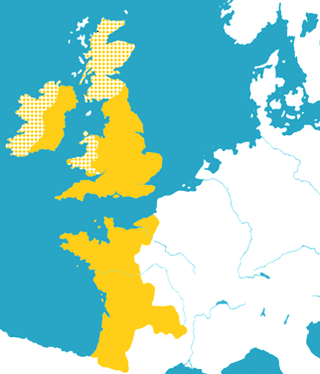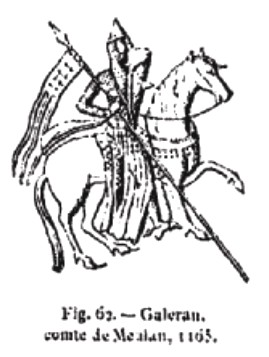Related Research Articles

Stephen, often referred to as Stephen of Blois, was King of England from 22 December 1135 to his death in 1154. He was Count of Boulogne jure uxoris from 1125 until 1147 and Duke of Normandy from 1135 until 1144. His reign was marked by the Anarchy, a civil war with his cousin and rival, the Empress Matilda, whose son, Henry II, succeeded Stephen as the first of the Angevin kings of England.

William the Conqueror, sometimes called William the Bastard, was the first Norman king of England, reigning from 1066 until his death. A descendant of Rollo, he was Duke of Normandy from 1035 onward. By 1060, following a long struggle to establish his throne, his hold on Normandy was secure. In 1066, following the death of Edward the Confessor, William invaded England, leading an army of Normans to victory over the Anglo-Saxon forces of Harold Godwinson at the Battle of Hastings, and suppressed subsequent English revolts in what has become known as the Norman Conquest. The rest of his life was marked by struggles to consolidate his hold over England and his continental lands, and by difficulties with his eldest son, Robert Curthose.
Roger Bigod was a Norman knight who travelled to England in the Norman Conquest. He held great power in East Anglia, and five of his descendants were earls of Norfolk. He was also known as Roger Bigot, appearing as such as a witness to the Charter of Liberties of Henry I of England.
Hugh Bigod, 1st Earl of Norfolk (1095–1177) was the second son of Roger Bigod, sheriff of Norfolk and royal advisor, and Adeliza, daughter of Robert de Todeni.

Roger Bigod was 4th Earl of Norfolk and Marshal of England.

Roger Bigod was the son of Hugh Bigod, 1st Earl of Norfolk and his first wife, Juliana de Vere. Although his father died in 1176 or 1177, Roger did not succeed to the earldom of Norfolk until 1189 for his claim had been disputed by his stepmother for her sons by Earl Hugh in the reign of Henry II. King Richard I confirmed him in his earldom and other honours, and also sent him as an ambassador to France in the same year. Roger inherited his father's office as royal steward. He took part in the negotiations for the release of Richard from prison, and after the king's return to England became a justiciar.

William Ætheling (Middle English:[ˈwiliəmˈaðəliŋɡ], Old English:[ˈæðeliŋɡ]; 5 August 1103 – 25 November 1120), commonly called Adelin was the son of Henry I of England by his wife Matilda of Scotland, and was thus heir apparent to the English throne. His early death without issue caused a succession crisis, known in English history as the Anarchy.

The Duchy of Brittany was a medieval feudal state that existed between approximately 939 and 1547. Its territory covered the northwestern peninsula of Europe, bordered by the Atlantic Ocean to the west, and the English Channel to the north. It was also less definitively bordered by the river Loire to the south, and Normandy, and other French provinces, to the east. The Duchy was established after the expulsion of Viking armies from the region around 939. The Duchy, in the 10th and 11th centuries, was politically unstable, with the dukes holding only limited power outside their own personal lands. The Duchy had mixed relationships with the neighbouring Duchy of Normandy, sometimes allying itself with Normandy, and at other times, such as the Breton–Norman War, entering into open conflict.

The now-extinct title of Earl of Richmond was created many times in the Peerage of England. The earldom of Richmond was initially held by various Breton nobles; sometimes the holder was the Breton duke himself, including one member of the cadet branch of the French Capetian dynasty. The historical ties between the Duchy of Brittany and this English earldom were maintained ceremonially by the Breton dukes even after England ceased to recognize the Breton dukes as earls of England and those dukes rendered homage to the King of France, rather than the English crown. It was then held either by members of the English royal families of Plantagenet and Tudor, or English nobles closely associated with the English crown. It was eventually merged into the English crown during the reign of Henry VII of England and has been recreated as a Dukedom.

The Revolt of 1173–1174 was a rebellion against King Henry II of England by three of his sons, his wife Eleanor of Aquitaine, and their rebel supporters. The revolt ended in failure after eighteen months; Henry's rebellious family members had to resign themselves to his continuing rule and were reconciled to him.

The term Angevin Empire describes the possessions held by the House of Plantagenet during the 12th and 13th centuries, when they ruled over an area covering roughly all of present-day England, half of France, and parts of Ireland and Wales, and had further influence over much of the remaining British Isles. It may be described as an early example of a composite monarchy. The empire was established by Henry II of England, who succeeded his father Geoffrey as Duke of Normandy and Count of Anjou. Henry married Eleanor of Aquitaine in 1152, acquiring the Duchy of Aquitaine, and inherited his mother Empress Matilda's claim to the English throne, succeeding his rival Stephen in 1154. Although their title of highest rank came from the Kingdom of England, the Plantagenets held court primarily on the continent at Angers in Anjou, and at Chinon in Touraine.
The Revolt of the Earls in 1075 was a rebellion of three earls against William I of England. It was the last serious act of resistance against William in the Norman Conquest.

The House of Mowbray was an Anglo-Norman noble house, derived from Montbray in Normandy and founded by Roger de Mowbray, son of Nigel d'Aubigny.

Ralph de Gaël was the Earl of East Anglia and Lord of Gaël and Montfort. He was the leading figure in the Revolt of the Earls, the last serious revolt against William the Conqueror.

Waleran de Beaumont (1104–1166) was an Anglo-Norman nobleman. In his early adulthood, he was a member of the conspiracy of Amaury III of Montfort; later in his career, he participated in the Anarchy and the Second Crusade. During the reign of Henry II of England, Waleran's close ties to Louis VII of France caused him to fall out of grace.
Events from the 1100s in England.

The House of Tosny was an important noble family in 10th and 11th century Normandy, though it did not include any comtes or vicomtes. Its founder was Raoul I of Tosny.
Ranulf le Meschin, 3rd Earl of Chester (1070–1129) was a Norman magnate based in northern and central England. Originating in Bessin in Normandy, Ranulf made his career in England thanks to his kinship with Hugh d'Avranches - the Earl of Chester, the patronage of kings William II Rufus and Henry I Beauclerc, and his marriage to Lucy, heiress of the Bolingbroke-Spalding estates in Lincolnshire.

William de Chesney was an Anglo-Norman magnate during the reign of King Stephen of England and King Henry II of England. Chesney was part of a large family; one of his brothers became Bishop of Lincoln and another Abbot of Evesham Abbey. Stephen may have named him Sheriff of Oxfordshire. Besides his administrative offices, Chesney controlled a number of royal castles, and served Stephen during some of the king's English military campaigns. Chesney's heir was his niece, Matilda, who married Henry fitzGerold.
Geoffrey Ridel was a landholder and royal justice during the reign of King Henry I of England.